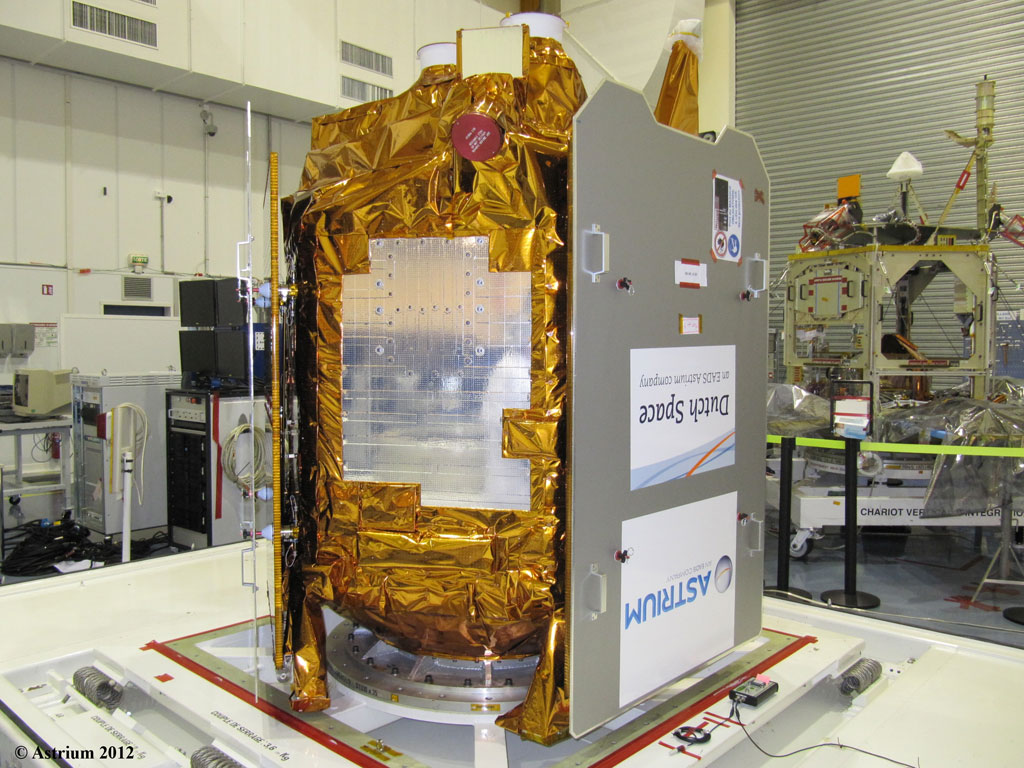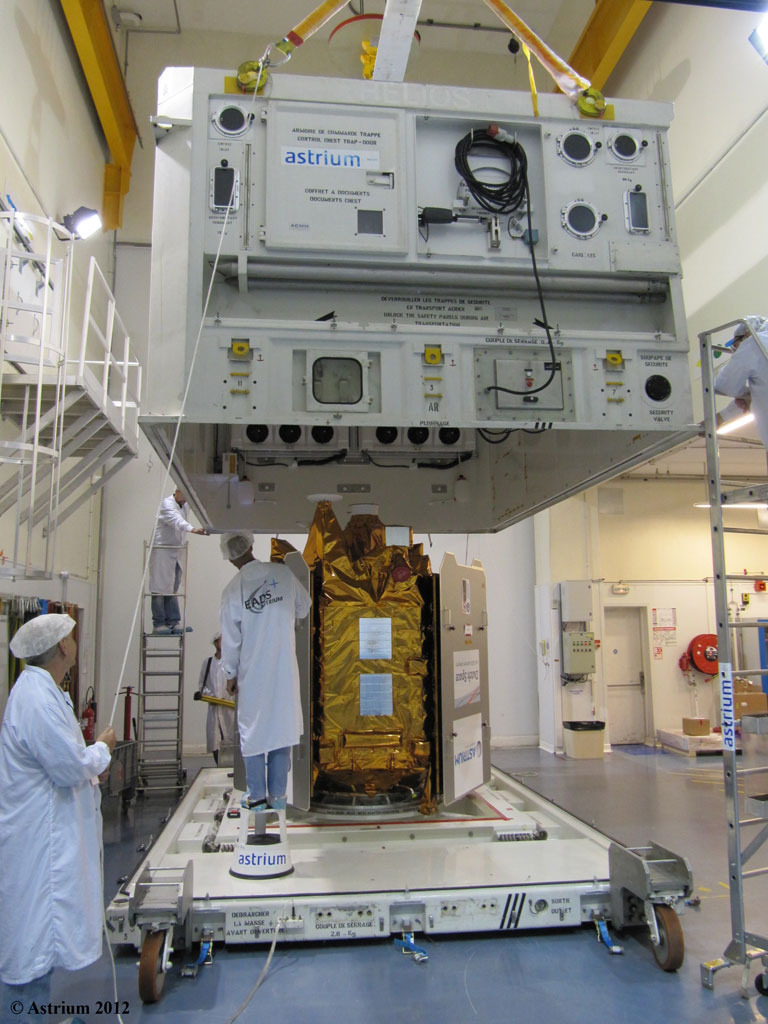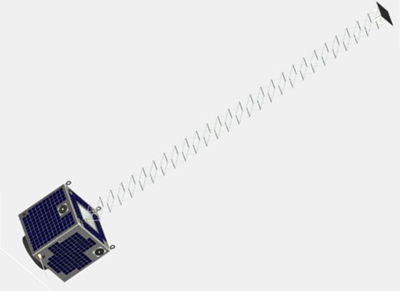In only the third time in history, an Indian rocket will carry a foreign satellite as its main payload. And not just any satellite - the main passenger is the heir to one of the longest lived European satellite family: the French SPOT Earth observation satellites. SPOT 6 carries twin stereo cameras to offer satellite photographs to commercial customers with resolution up to 1.5 meters. The field of view reaches up to 60 kilometers on each side. With a lifetime of at least 10 years (which even the older satellites easily exceeds), SPOT 6 is destined for a long productive life.
Unlike many other Indian launches, this one only carries one micro-satellite: the Japanese PROITERES. Build by students and faculty members of the Osaka Institute of Technology, the 15 kilogram satellite will test an electric ion thruster, imaging the Earth with a camera, and allow for amateur radio tracking.
Launch time: 9 September, 2012, 04:21 UTC (09:51 INST)
[highlight][eventTimer]2012-09-09 04:21:00[/eventTimer][/highlight]
Launch site: First Launch Pad, [ame="http://en.wikipedia.org/wiki/Satish_Dhawan_Space_Centre"]Satish Dhawan Space Centre[/ame], Sriharikota, Andhra Pradesh, India (13.733 N, 80.235 E)
Target orbit: 655 X 655 km, 98.23 degrees inclination
Payload 1:
SPOT 6 (Satellite Probatoire de l'Observation de la Terre) is a high resolution optical Earth observation satellite. Like its twin SPOT 7, which is slated for launch early 2014, SPOT 6 will have a 60-km swath width and produce imagery products with a resolution down to 1.5 metres. SPOT 6 and SPOT 7 will ensure service continuity from the SPOT 4 and SPOT 5 satellites, which have been operating since 1998 and 2002 respectively.
Both ground and space segments have been designed for improved performance compared with previous SPOT missions, especially in terms of responsiveness - from satellite tasking to product delivery - and collection capacity. Moreover, SPOT 6 and SPOT 7 are “agile” as they can quickly be aimed at any point within 1500km of their position. The constellation SPOT 6 and SPOT 7 will actually provide a daily revisit everywhere on Earth with a total coverage of 6 million km² per day.
As soon as they are validated in orbit, SPOT 6 and SPOT 7 will be operated by Astrium Services in coordination with the two Pléiades satellites which will be in the same orbit. The constellation will offer unique applications, in an unrivalled delivery time, to Astrium Services’ customers. Every point on the globe will be able to be seen every day, once in high resolution and also in very high resolution. In addition while SPOT 6 and SPOT 7 will provide a wide view over a large area, Pléiades 1A and Pléiades 1B will be able to offer, for the same zone, products with a narrower field of view but with an increased level of detail (50cm).
Based on the newly designed Astrium Astrosat 500 MklI platform, SPOT 6 and SPOT 7 offer enhanced performance compared with their predecessors and are also lighter (weighing 720kg against SPOT 5’s 3 tonnes), thanks to the use of latest-generation technologies including silicon carbide, a brand-new detector for the instrument, and new avionics for the satellite. Both satellites will have a service life of 10 years.
In addition to the satellites, Astrium has complete responsibility for the design and manufacture of the ground segment, the launch of the satellites, qualification and maintenance of the system, and the satellite command and control operations. The overall lead time for the whole system, 3.5 years, demonstrates that Astrium’s improvement programs have delivered results, reaching benchmark efficiency, putting technology at the service of quality, speeding up manufacture and reducing the level of project risk. All these improvements have contributed to the success of SPOT 6, from instruments to platforms and satellite assembly, integration and test (AIT), and from ground segment to data processing techniques.
Some parameters of the satellite:
- Mass: 712 kg
- Main payload: Two high-resolution cameras with resolution of 1.5 meters for the photographs (0.455 µm – 0.745 µm) and 6 meters for spectral data (in the blue, green, red and near-infrared bands)
- Imaging swath: 60 km at nadir (max strip length = 600 km)
- Viewing angle: Max +/- 45° pitch and roll, +/- 30° to keep pixel size<3m
- Nominal mission life: 10 years
- Acquisition capacity: 3 million sq.km/day





Payload 2: PROITERES (PRoject of OIT Electric-Rocket-Engine Onboard Small Space Ship)
A team of students and faculty members of Osaka Institute of Technology (OIT) are now developing a small satellite called MicroSat with an electric propulsion rocket engine, which is installed with radio equipment. The project called PROITERES (PRoject of OIT Electric-Rocket-Engine Onboard Small Space Ship) aims to demonstrate powered-flight technology for an ultra-small satellite and to monitor the Kansai District with a high-resolution camera. PROITERES also aims to reduce development costs and shorten the development period drastically by miniaturizing the satellite and its component parts.
The project will focus on:
- Experimental verification of two-way radio signal propagation characteristics using amateur radio-frequency bands.
- Communication tests and their feedback aiming at improvement of satellite communication technology by using off-the-shelf consumer goods.
- Tracking and communicating with our satellite by amateur earth stations all over the world.
- Powered-flight by electric rocket engine.
- Monitoring with a high-resolution camera the Kansai District; especially Osaka, around Yodogawa basin.


Launch procedures:
Launch vehicle
The PSLV (Polar Satellite Launch Vehicle) is India's main launch vehicle for Earth observation satellites and other various small satellites. With 19 launches to date since 1991, it achieves successes in all but the first flight. The CA version removed the boosters compared with the original PSLV version, with the ability of launching a 1100 kg payload into a circular 620 km, sun-synchronous (98.8 degrees inclincation) orbit.

The 4-stage vehicle is quite unusual in the mix-matching of stages: the 1st and 3rd stages use solid propellant, while the 2nd and 4th stages use hypergolic fuel.
Launcher parameters:
First stage- Engines 1 solid
- Thrust 4,860 kN
- Specific impulse 269 sec
- Burn time 105 seconds
- Fuel HTPB (solid)
Second stage- Engines 1 Vikas (liquid)
- Thrust 725 kN
- Specific impulse 293 sec
- Burn time 158 seconds
- Fuel N2O4/UDMH
Third stage- Engines 1 solid
- Thrust 328 kN
- Specific impulse 294 sec
- Burn time 83 seconds
- Fuel Solid
- Fourth stage
- Engines 2 liquid
- Thrust 14 kN
- Specific impulse 308 sec
- Burn time 425 seconds
- Fuel MMH/MON
Pictures and videos









Video of the rocket and satellites being integrated
P.S. One Indian English news channel or another should carry the launch live, including this one: Link
References
http://forum.nasaspaceflight.com/index.php?topic=29471.0
http://www.isro.org/pslv-c21/pdf/pslv-c21-brochure.pdf
http://www.isro.org/pslv-c21/Imagegallery/launchvehicle.aspx
[ame="http://en.wikipedia.org/wiki/PSLV"]http://en.wikipedia.org/wiki/PSLV[/ame]
http://space.skyrocket.de/doc_sdat/spot-6.htm
http://space.skyrocket.de/doc_sdat/proiteres.htm
http://www.astrium-geo.com/en/147-spot-6-7
http://www.astrium-geo.com/files/pmedia/public/r2928_9_geo_0012_spot_6_7_en_2012_03.pdf



